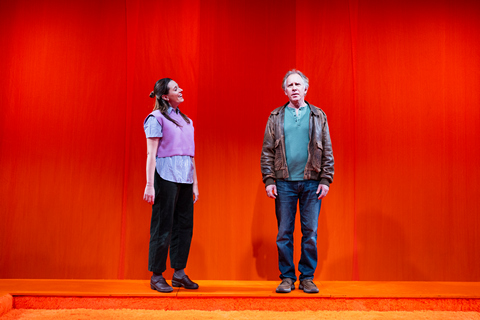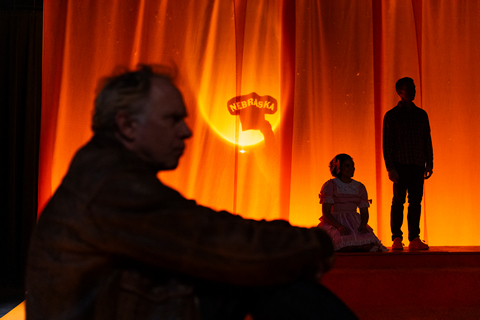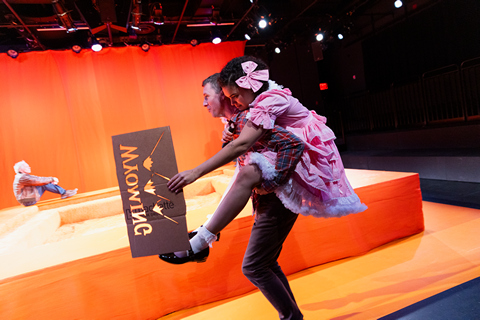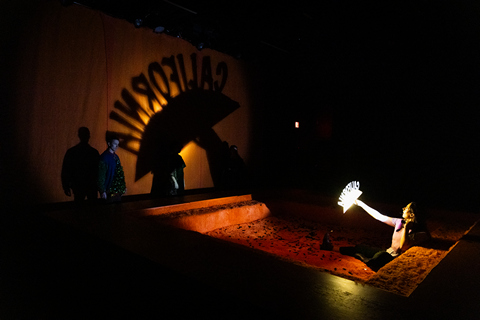Racecar Racecar Racecar
This story operates from a different dimension the moment one walks into the performance space.

Julia Greer and Bruce McKenzie in a scene from Kallan Dana’s “Racecar Racecar Racecar” at Mezzanine Theatre at A.R.T./New York Theatres (Photo credit: Travis Emery Hackett)
“Where in the world is Waldo?” is a strange question to ask of a child, yet it leads to an adventure-filled journey for children. A striped-shirted character with a red and white knitted stocking cap hiding in plain sight or perhaps not. What if, as an adult, the search for a character took a different form? What if the search was composed of words and phrases that were used to occupy a child’s mind on a long road trip, a palindromic adventure with words, “Madam, I’m Adam.” or perhaps, “A man, a plan, a canal, Panama!”
Racecar Racecar Racecar is the palindromic name of an avant-garde surrealistic play by Kallan Dana. It was initially scheduled at the Connelly Theater before the Archdiocese of New York imposed restrictions on productions there, which would have involved censorship. The Hearth decamped to the A.R.T./New York Theatres where restrictions on artistic expression is not limited by dogma.
Sarah Blush directs a cast of five in the story of a father and daughter on a road trip from New York City to a storage unit in California. It is a trip that is both se in the present and past, and it is filled with a flow of information that mixes reality with fantasy in a liminal space between sanity and insanity. This story operates from a different dimension the moment one walks into the performance space. The set is a large orange square, shag-carpeted pit with no clues as to the staging. The two principal characters making this trip by car never sit as if they are in a car but casually walk the raised outside edge of the box. It is an element of this stagecraft that adds beautifully to the edginess of the production.
The opening scene introduces Dad (Bruce McKenzie) and Daughter (Julia Greer), who are departing on a car trip from New York City to California to empty Dad’s storage unit. McKenzie and Greer are solidly believable in their characters. McKenzie shows a man with a veneer of calm hiding internal emotional turmoil. Greer gives us a woman-child in conflict with her feelings and her perception of reality.

Bruce McKenzie, Camila Canó-Flaviá and Ryan King in a scene from Kallan Dana’s “Racecar Racecar Racecar” at Mezzanine Theatre at A.R.T./New York Theatres (Photo credit: Travis Emery Hackett)
As they start, the banter is light but strained, remembering another trip years before, a fact that will play out throughout the show. As they move from state to state, the place they are passing through is projected on the walls of the performance space. The projections are cleverly handled by other cast members holding cutouts of state names and using flashlights to project the names on the walls. This action takes a decidedly different turn towards the end of the show when the names are projected in reverse.
The interactions during the drive to California include moments of confused dialogue as Dad and Daughter play at the palindromic game while gently probing each other for details on who they are now and who they were then. Added to these moments of discontinuity are a number of incidents that add to the developing surrealistic nature of the journey.
The first encounter is with an Old Lady (Camila Canó-Flaviá) on the road in Ohio after Dad bangs into the rear of her car. He wants to drive on but Daughter insists on speaking with the woman and exchanging insurance information. What transpires is a dialogue that introduces a question about the reality of the trip to California. When Daughter offers to provide the insurance information, the Old Lady says that she already has it all and, in the course of the conversation, reveals things about Daughter that are true.
The next incident happens in Indiana when they stop at a rest area. Daughter goes for a cup of coffee and is confronted by Ragged Man (Ryan King). This encounter adds to the developing unreality of Daughter’s experience, as the Ragged Man insists the two of them have met before.

Bruce McKenzie, Ryan King and Camila Canó-Flaviá in a scene from Kallan Dana’s “Racecar Racecar Racecar” at Mezzanine Theatre at A.R.T./New York Theatres (Photo credit: Travis Emery Hackett)
DAUGHTER: No, I don’t think so! I’m not from here!
RAGGED MAN: Neither am I! I think we’re both from the same place, both from somewhere else besides here, and that’s where I think I know you from. I think I know you from that somewhere else we’re both from.
Dad gets involved in the encounter, and when Dad and Daughter get in the car and begin to drive away, Dad goes into a rant that provides more suggestions as to his state of mind and elements that may be related to Daughter’s state of mind. At the end of the rant, he says, “you know that I fall asleep and underneath my eyelids I see your skull’s dusty crumbs, right?”
The next encounter provides more direct insight into Daughter’s psyche. While driving through Illinois during a snowstorm, they encounter a man and a little girl hitchhiking. They stop and pick them up, and what transpires over the many miles to follow is dialogue introducing creepy and disturbing things about the Handsome Man (King) and a creepy Little Girl beautifully portrayed by Canó-Flaviá. This encounter marks a pivotal point in the story as the palindromes turn darker and the questions raised by Little Girl’s presence with Handsome Man suggests disturbing things from Daughter’s past. It all ends when they exit the car in Wyoming.
An encounter at a Wendy’s drive-in in Utah with someone named Wendy (Jessica Frey) exposes another aspect of Dad and a perplexing element to the unraveling reality of Daughter. Nevada leads to an argument and car accident. At this point, Dad and Daughter fall into the shag-carpeted pit, and Dad disappears. The scene becomes a Christmas party in California, and so much more happens as Daughter’s life begins to be exposed.

Ryan King, Julia Greer and Camila Canó-Flaviá in a scene from Kallan Dana’s “Racecar Racecar Racecar” at Mezzanine Theatre at A.R.T./New York Theatres (Photo credit: Travis Emery Hackett)
Who are the guests at the party? Strangers? Her sisters? The whole moment becomes a confusion of distorted moments from a childhood possibly filled with emotional and physical trauma. The interactions gradually reduce to just two people, Daughter and Pretty Woman. As Pretty Woman leaves the conversation, Dad reappears, and the trip rapidly reverses to New York City in a non-palindromic way, closing with a whimper in dramatic contrast to the impact of what transpired in the California encounters. Canó-Flaviá, King, Frey, and McKenzie (not as Dad) solidly embody the characters at the party and in its immediate aftermath.
Normandy Sherwood’s costume and prop design clearly define the characters while supporting the surreal nature of the production. Brittany Vasta’s set design of the square, shag-carpeted pit challenges audience expectations the moment they walk to their seats. The combination of lighting design by Cha See and Bev Fremin and sound design by John Gasper provides solid support to the sense of unreality experienced by the characters and the audience.
Racecar Racecar Racecar is a production to be experienced with no expectations of where it is going. It is a play that demands careful consideration of what is being expressed through the interactions of the main characters and how it all fits into what is considered reality and whose reality it is.
Racecar Racecar Racecar (through December 22, 2024)
The Hearth
Mezzanine Theatre at A.R.T./New York Theatres, 502 W. 53rd Street, in Manhattan.
For tickets, visit https://www.tickettailor.com/events/thehearththeater/1400987
Running time: 75 minutes without an intermission






Leave a comment